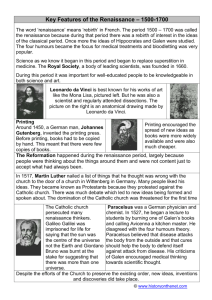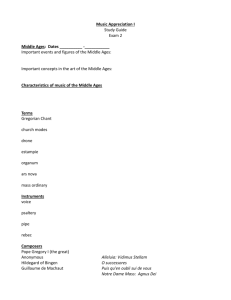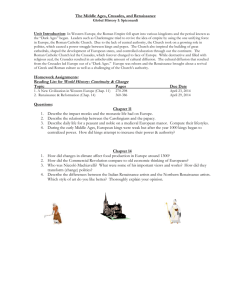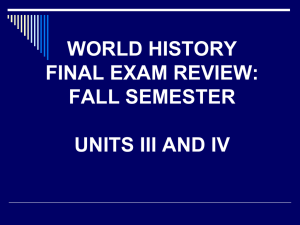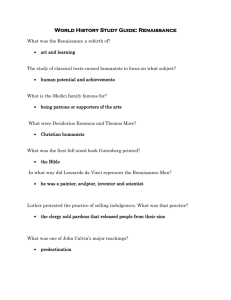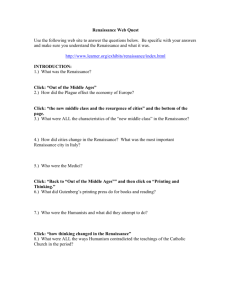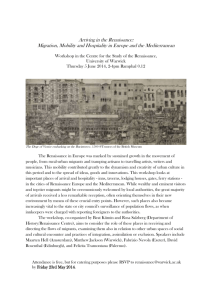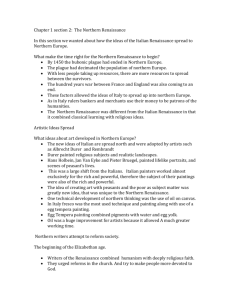Renaissance-Notes
advertisement
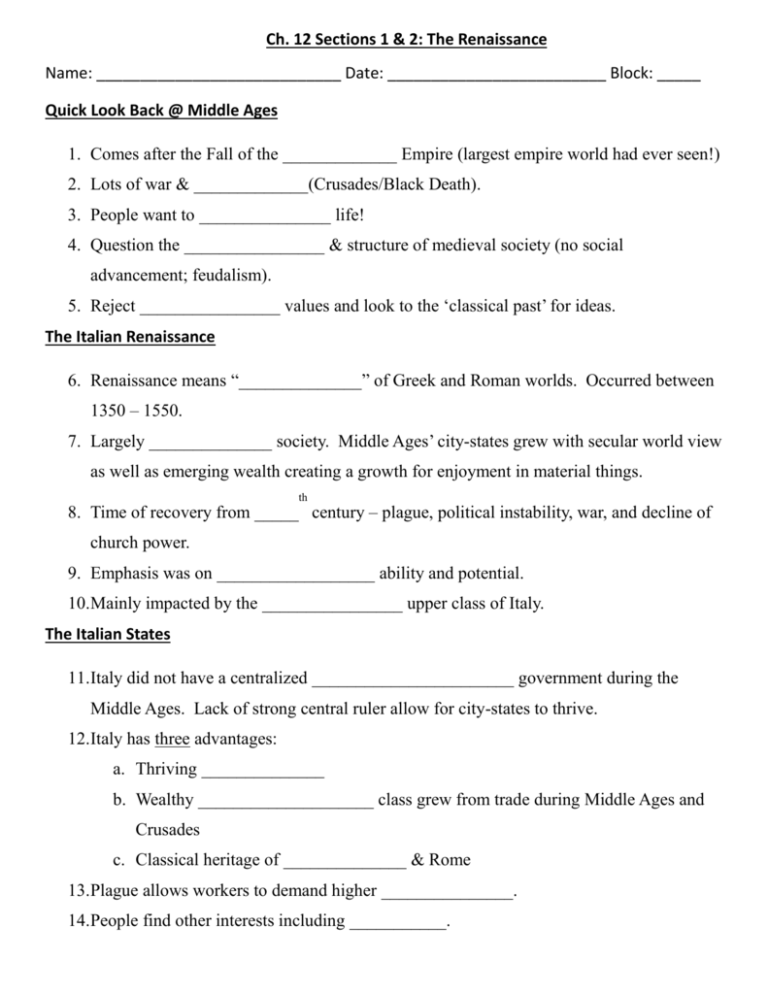
Ch. 12 Sections 1 & 2: The Renaissance Name: ____________________________ Date: _________________________ Block: _____ Quick Look Back @ Middle Ages 1. Comes after the Fall of the _____________ Empire (largest empire world had ever seen!) 2. Lots of war & _____________(Crusades/Black Death). 3. People want to _______________ life! 4. Question the ________________ & structure of medieval society (no social advancement; feudalism). 5. Reject ________________ values and look to the ‘classical past’ for ideas. The Italian Renaissance 6. Renaissance means “______________” of Greek and Roman worlds. Occurred between 1350 – 1550. 7. Largely ______________ society. Middle Ages’ city-states grew with secular world view as well as emerging wealth creating a growth for enjoyment in material things. th 8. Time of recovery from _____ century – plague, political instability, war, and decline of church power. 9. Emphasis was on __________________ ability and potential. 10.Mainly impacted by the ________________ upper class of Italy. The Italian States 11.Italy did not have a centralized _______________________ government during the Middle Ages. Lack of strong central ruler allow for city-states to thrive. 12.Italy has three advantages: a. Thriving ______________ b. Wealthy ____________________ class grew from trade during Middle Ages and Crusades c. Classical heritage of ______________ & Rome 13.Plague allows workers to demand higher _______________. 14.People find other interests including ___________. 15.Merchant class dominated ___________________, church weak. 16.______________family rule Florence - HUGE patrons of the Arts. Niccolo Machiavelli & The Prince 17.15____ Political guidebook. 18.How a _______________ can gain power & keep it in spite of enemies. 19.People are selfish, fickle, and ___________________. 20.Prince acts for the state. Do good when possible, ____________when necessary. “The ends justify the means”. Renaissance Society 21.Middle Ages division of 3 estates (clergy, _______________, and peasants/townspeople). 22._______________ (2-3% of population) helped important political posts and advisers to kings 23.________________ were 85-90% of population – serfdom decreased with decline in manorial system rd 24.__________________ were rest of 3 estate – patricians (wealth from trade, industry, banking), burghers (shopkeepers, artisans, guild masters), and workers/unemployed. 25._____________________ were arranged, dowry included. Children became adults when father freed them. Development of Humanism 26._________________: the focus on human potential and achievements. 27.Scholars look to classic texts (Greek & Roman), life of ___________________. 28.Society moves towards ___________________ traditions: moral philosophy, history, literature, eloquence (rhetoric), letters, math, poetry, astronomy, music. 29.Few _________________ were allowed, religion and morals were at front of girl’s education. Vernacular Literature & Education 30.Some authors wrote in the ___________________ (author’s native language) rather than in classical Latin. 31.Dante wrote in ________________ and Chaucer in ______________ helped spread popularity. 32.1440: ____________________ reinvents movable type and printing press. 33.1455: Gutenberg ______________ – first full size book printed with movable type. 34.Believed liberal studies helped people reach their __________________. 35.Aim was not to create scholars but complete ___________________, civic duty. Changing Values 36.People think they might be able to enjoy life without offending ___________. 37.Wealthy ____________________enjoy material luxuries, fine music, tasty food. 38.People became ______________: worldly and concerned with the here and now. 39.Many remain ___________________. 40.Church ____________________ become secular – live in beautiful mansions, throw lively banquets, wear expensive clothing, and spend lots of $$ for art. Printing Press Changes Society 41._______________ are cheaper. 42.New ______________ spread faster. 43.People encouraged to read so ____________________ increases. 44.Bibles printed in ___________________. 45.People ____________________ the bible for themselves & become critical of priests and their behaviors…leads to religious reform. Renaissance Man: Leonardo Da Vinci 46.Well-rounded, __________________ person who could achieve in many areas: painter, sculpture, architect, inventor, and mathematician. 47.one of the greatest ________________ of all time. Artist: Raphael 48.Supreme _______________ th 49.Style dominated European painting ‘til mid-19 century 50.Noted painters of Madonna’s 51.Ideal of beauty in paintings 52.Painted “School of Athens” Artist: Michelangelo 53.Painter, sculpture, architect (on panel & in fresco) 54.1508-1512: painted the ceiling of the ________________ Chapel. Painted “ideal human body”. 55.Sculptures: the Pieta, the ________________ Textbook Questions Pg. 399 1. What does “School of Athens” show about how the Italians viewed the Ancient Greeks? 2. Who was intended to be in the middle of the painting? Pg. 401 3. How did the Medici influence the Renaissance in Florence? Pg. 402 4. What technologies did Gutenberg bring together in his printing press? 5. How did the printing press contribute to the Renaissance? Pg. 407 1. Why did Dante choose not to write his Divine Comedy in Latin? HOT Questions! 1. Why do you think Leonardo da Vinci is considered a “Renaissance Man”? 2. What attributes do you think families looked for to marry their child? What would American families look for today? 3. Who would you consider a “Renaissance person” today and why?
